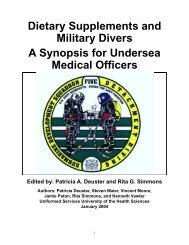Force Health Protection: Nutrition and Exercise Resource Manual
Force Health Protection: Nutrition and Exercise Resource Manual
Force Health Protection: Nutrition and Exercise Resource Manual
Create successful ePaper yourself
Turn your PDF publications into a flip-book with our unique Google optimized e-Paper software.
◆ Does not cause gastrointestinal or stomach discomfort.<br />
◆ Is rapidly absorbed from your gut, especially when exercising.<br />
◆ Contains electrolytes (see Glossary) <strong>and</strong> CHO (5% to 8%) when<br />
performing prolonged or strenuous exercise.<br />
◆ Rehydrate with a non-caffeinated, non-carbonated, non-alcoholic<br />
beverage.<br />
Overhydration<br />
Although less common than dehydration, untreated<br />
overhydration can be life threatening. It is seen when<br />
plain water is used to replace fluid losses during<br />
prolonged (greater than 3 hours) strenuous exercise.<br />
Remember, water <strong>and</strong> electrolytes are lost during<br />
sweating, so both need to be replaced in this situation.<br />
Overhydration decreases the concentration of electrolytes in the body, upsets<br />
metabolism <strong>and</strong> other bodily functions, <strong>and</strong> is just as harmful as dehydration.<br />
Prevent overhydration by drinking a beverage that contains electrolytes<br />
(such as a sport drink) or by eating a light snack (e.g., oranges) with your<br />
water. Between exercise sessions, electrolytes lost through sweating can be<br />
easily replenished by eating well-balanced meals <strong>and</strong> snacks (Chapter 3).<br />
<strong>Nutrition</strong> for <strong>Exercise</strong> Recovery<br />
Within 30 minutes of completing an extended or intense exercise session,<br />
consume at least 50 grams of CHO (roughly 200 kcals). Also, continue to<br />
snack on high-CHO foods for up to six hours. This will help restore your<br />
muscle glycogen for the next exercise session. Some foods <strong>and</strong> servings sizes<br />
that contain roughly 50 grams of CHO are:<br />
◆ Bagel with jam<br />
◆ Baked potato with skin<br />
◆ Cooked sweet corn, 1.5 cups ◆ Bananas (2)<br />
◆ Cornflakes, 2.5 cups<br />
◆ Watermelon, 4.5 cups<br />
◆ Raisins, 0.4 cup<br />
◆ Shredded wheat cereal, 1.4 cups<br />
◆ Baked Beans, 1 cup<br />
◆ Cooked oatmeal, 2 cups<br />
◆ Cooked Rice, 1 cup<br />
◆ Orange juice, 2 cups<br />
For more information on the CHO content of foods, check food labels<br />
(Figure 3-2), check the USDA website at http://www.usda.gov, or ask a<br />
dietitian.<br />
<strong>Nutrition</strong> <strong>and</strong> <strong>Exercise</strong> <strong>Resource</strong> <strong>Manual</strong> 91




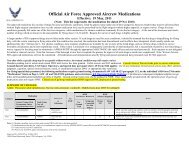

![Body Composition and Military [PDF] - Human Performance ...](https://img.yumpu.com/43269347/1/190x245/body-composition-and-military-pdf-human-performance-.jpg?quality=85)
![Tips for Grocery Shopping [PDF]](https://img.yumpu.com/37447379/1/190x245/tips-for-grocery-shopping-pdf.jpg?quality=85)
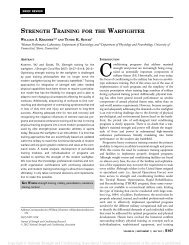
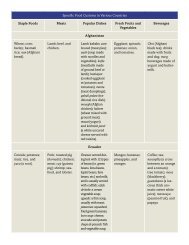
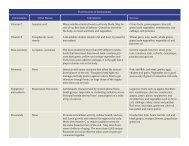
![Synthetic Drugs [PDF] - Human Performance Resource Center](https://img.yumpu.com/37447322/1/190x245/synthetic-drugs-pdf-human-performance-resource-center.jpg?quality=85)
